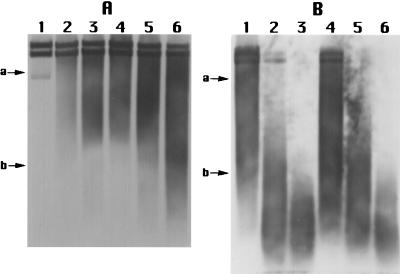FIG. 4.
DNA damage to wild-type and α−β− spores by EtO treatment. Spores of the wild-type (PS533) and α−β− (PS578) strains were lyophilized and subjected to EtO treatment (2 min, 55°C, 10% relative humidity) or a mock EtO treatment by use of the instrument described in Table 1, footnote b. DNA was isolated, denatured with glyoxal with or without prior piperidine treatment, and electrophoresed on agarose gels; the DNA was transferred to Hybond N membranes; and pUB110 sequences were detected as described in the text. (A) The samples were run without piperidine treatment. (B) The samples were run with piperidine treatment. The samples in lanes 1 to 3 are from spores of PS533 (wild type); those in lanes 4 to 6 are from spores of PS578 (α−β−). Samples in lanes 1 and 4 were only lyophilized and kept dry for ∼4 to 8 days; samples in lanes 2 and 5 were treated similarly but were subjected to mock EtO treatment; and samples in lanes 3 and 6 were subjected to EtO treatment. Arrows a and b denote the positions of 3.5- and 1-kb DNA size markers. Percentages of survival of the spores analyzed in the various lanes relative to untreated spores were as follows: 1, 100%; 2, 85%; 3, 4.5%; 4, 10%; 5, <0.05%; and 6, <0.05%.

